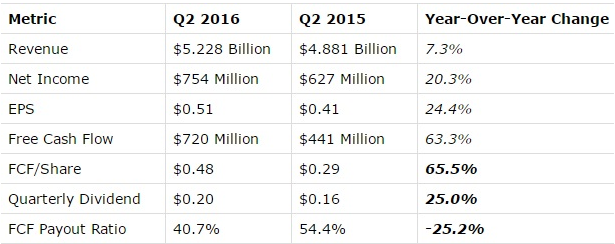Since its founding in Seattle in 1985, Starbucks (SBUX) has grown into the world’s largest coffee empire and the 67th most valuable brand on earth. Along the way, Starbucks’ amazing growth story has made countless investors amazingly rich.
For example, $10,000 invested in Starbucks 20 years ago would today be worth $283,520.03 compared to just $44,044.43 invested in the S&P 500.
That’s annual total compound returns of 18.1% and 7.7%, respectively, showing just how well founder, CEO, and Chairman Howard Schultz has been at generating long-term wealth for his shareholders.
Of course past performance is no guarantee of future success, and one must always invest with an eye towards future growth, not just past glories (see seven other effective habits of dividend investors here). However, when you dig deep into Starbucks’ business model and factor in management’s growth plans, the company’s best days could still lie ahead of it.
Let’s take a closer look at this business for consideration in our Long-term Dividend Growth portfolio to see if dividend growth investors should climb on board the Starbucks Espresso train.
Business Description
Starbucks is the world’s largest coffee purveyor with just over 24,000 stores in 72 countries, where it sells not just premium coffee but also tea, packaged coffee, juices, bottled water, pastries, and various lunch items.
In addition, the company licenses several of its products, which are available in supermarkets and stores, and operates other up and coming fast casual restaurant brands such as Teavana, Tazo, Seattle’s Best Coffee, Evolution Fresh, La Boulange, and Ethos.
In its most recent quarter, the vast majority of its sales came from the company’s namesake, company owned stores.
Source: Earnings Release
By geography, Starbucks generated 69% of its revenue last year in the Americas (U.S., Canada, Latin America); 13% in China / Asia Pacific; and 6% in Europe, Middle East, and Africa. The remaining 12% of revenue was related to channel sales of Starbucks’ products and other business segments.
Business Analysis
Despite its already massive size, Starbucks has been able to generate impressive sales, earnings, and free cash flow (FCF) growth over the last few years.
This strong growth is largely due to Starbucks’ ability to continue bringing in more foot traffic to its stores and raise prices consistently thanks to its strong brand, which gives it a solid moat against rivals such as Dunkin Brands (DNKN).
Even more impressive than its solid top line growth however, is Starbuck’s ability to grow its bottom line earnings and FCF per share, which funds the growing dividend, even faster.
In fact, thanks to increased cost efficiencies made possible from its vast economies of scale and hyper efficient supply chain, Starbucks was able to grow FCF per share, one of the most important dividend metrics, by an astounding 65.5% year-over-year last quarter.

Source: Earnings Release, 10-Q
This continues the company’s amazing record of not just maintaining its margins over time, but substantially growing them as well. This just shows true power of Starbucks’ premium brand and the strong pricing power it commands.
This also explains how management was able to reward investors with a sensational 25% dividend increase and still lower the FCF payout ratio. That helps to not just make the current payout more secure (more on this later), but also increases the likelihood that the dividend will be able to keep growing quickly for years to come.
But as impressive as the company’s fast sales, and margin expansion has been, investors need to always ask themselves, “Where will continued growth come from?”
In Starbucks’ case, management has three pronged plan to keep the growth train humming.
First, the company continues to open and license new stores around the globe, especially in fast growing emerging markets such as China. In fact, over the next five years Starbucks plans to more than double its locations in the world’s most populous nation to over 5,000.












Leave A Comment